
The Corniche is a waterfront promenade in Alexandria Egypt, running along the Eastern Harbor. It is one of the major corridors for traffic in Alexandria. The western end starts by the Citadel of Qaitbay, built in place of the Lighthouse of Alexandria, one of the Seven Wonders of the Ancient World. It runs for over ten miles and ends by the Montaza Palace. Downtown Alexandria's wide waterfront road is as much a symbol of the city as any of its monuments. It's here that you get a real feel for the era of cosmopolitan elegance and decadence that marked this city in the late 19th and early 20th centuries. Much of the architecture from this era still stands along the Corniche, though these days, much of it is heavily dilapidated and falling into disrepair. Despite appearances however, ocean front property is as valuable here as it is elsewhere in the world and it is along this promenade that Egypt has lavished large amounts of capital.

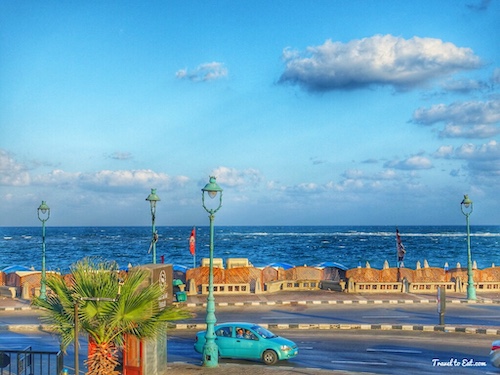

When I visited Alexandria, I stayed at the Sheraton Montazah Hotel, an excellent hotel at the end of the Alexandria corniche promenade. This is a high end location with a private beach club and tight security.



The beach up to the small promontory is named Mamura beach and is made up of primarily of private beach clubs and restaurants.

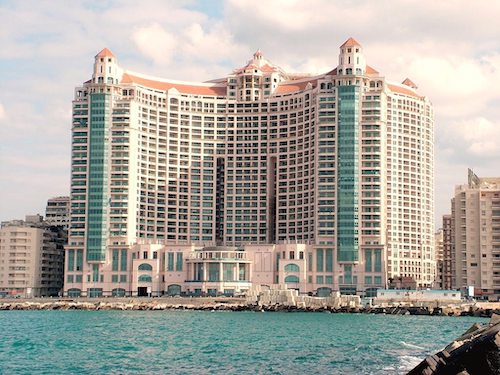
San Stefano Grand Plaza is a complex including a Four Seasons hotel, apartments, offices, a shopping mall and a marina. It is something of a landmark along the corniche/promenade.


The Stanley Bridge project was a part of the upgrading and widening works for the Alexandria Corniche, and it is the first bridge to be constructed in the sea in Egypt. One of the main aims was to build a superior bridge to represent the tradition and glory of Alexandria. The neo-Islamic towers at both ends of the bridge, reminiscent of the architecture of Montazah Palace, suit the situation perfectly. The project cost was about 75 million Egyptian pounds.



Mahmud Bayram el-Tunsi (1893-1961) was an Tunisian-Egyptian poet who was exiled from Egypt by the British for his nationalist poetry. In 1919, the year of the first Egyptian revolution, he began to publish his poetry in the journal Issues. These satirical ballads, based on the traditional zajal form, were critical of both the British occupation and the Egyptian monarchy, which was referred to as a puppet. This led to his exile from Egypt, which he spent in France and Tunisia. El-Tunsi returned to Egypt in 1938, where he continued to publish political poetry.







Across from the Bibliotheca Alexandrina is a small but well used park with a single marble pillar in the center. The Eastern Harbor begins at the Bibliotheca Alexandrina and curves around to end at Quaitbay Citadel, the supposed site of the famous Lighthouse of Alexandria in antiquity. The Selsela café is a nice little place across from the Bibliotheca and the little park that I stopped in for coffee. It is right on the beach and is good while not expensive.

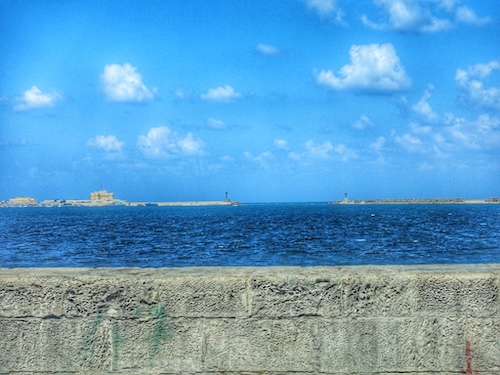



The Saad Zaghloul Square, also known as Raml Station, is the city's downtown square. Cleopatra's needles once stood here. The renovated historic Cecil Hotel is one of the main buildings built early in the 20th century. Saad Zaghloul (1859-1927) was an Egyptian revolutionary, and statesman. Zaghloul was the leader of Egypt's nationalist Wafd Party. He served as Prime Minister of Egypt from January 26, 1924 to November 24, 1924. This grassy square and statue is dedicated to him.





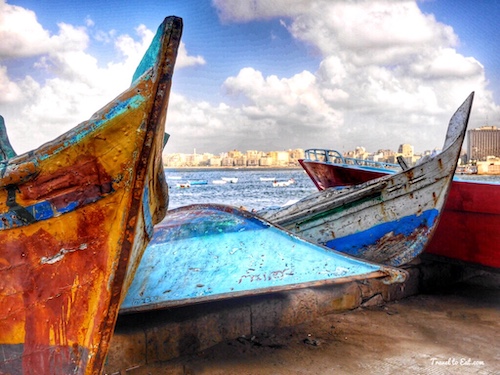


Alexandria's ports consist of two harbors (east and west) which are separated by a T-shaped peninsula. The east harbor is shallow and is not navigable by large vessels. The west harbor is used for commercial shipping. The harbor is formed by two converging breakwaters. As you can see, the housing fronting the East Harbor on the peninsula is much older and more European than in other parts of the corniche. The streets are wider and the entire effect shows what the city might have looked like in its heyday, around the turn of the century. In fact, the entire “peninsula” is man made, originally created by Alexander the Great in 332 BC when he founded the city of Alexandria. He built an earthen causeway more than three-quarters of a mile long between the city of Alexandria and the nearby island of Pharos called the Heptastadium. This created the east (Great) and west (Eunostus) harbors that are still used today. As time went by the causeway became widened by silt until it became the land we see today.



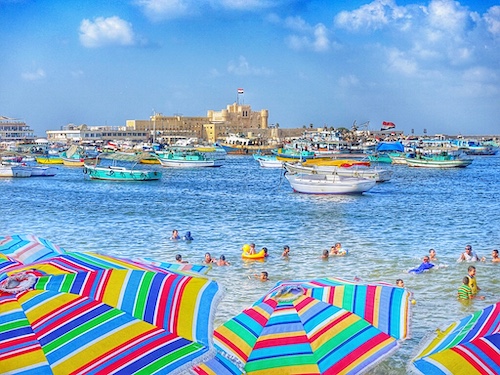

The Lighthouse of Alexandria, sometimes called the Pharos of Alexandria was a lighthouse built by Ptolemy between 280 and 247 BC which was between 393 and 450 ft (120 and 137 m) tall. The building soon became known simply as Pharos (after the name of the island). “Pharos” continues to be the root word for “lighthouse” in many modern languages for example in Italian/Spanish: Faro, French: Phare, Greek: Φαρος, Norwegian/Swedish: Fyr. One of the Seven Wonders of the Ancient World, it was one of the tallest man-made structures in the world for many centuries. Badly damaged by three earthquakes between 956 and 1323 CE, it then became an abandoned ruin. In 1480 CE the last of its remnant stones were used to build the Citadel of Qaitbay on the site. In 1994, French archaeologists discovered some remains of the lighthouse on the floor of Alexandria's Eastern Harbor. The light was produced by a furnace at the top and the reported cleanliness of ancient Alexandria may be attributed to burning of trash in the lighthouse.

Many of the greatest scholars of the ancient world lived in Alexandria and frequented Alexandria. So, too, did Jews, Syrians, and Greeks, since Alexandria was the center of the Hellenistic civilization in which Greek culture mingled with that of North Africa and the East. By the early 20th century, Alexandria had become a home, not for mathematicians and astronomers, but for novelists and poets, including my favorite, Lawrence Durrell, author of the famous Alexandria Quartet set in the 1940s. North Africa used to be a civilizational crossroads in which Muslims, Christians, and Jews not only lived alongside one another but also shared one another's language and culture. This mingled society, formed from many intense particularities, is what made Alexandria a true cosmopolitan city. Cosmopolitan Alexandria came to a crashing end with the rise of the Arab nationalism championed by President Gamal Abdel Nasser. In the burst of nationalism following the 1956 Suez War, the Europeans began to pack their china and silver in dusty suitcases long prepared for the inevitable moment of flight, and joined relatives in Paris or London, Athens or Rome. Today Alexandria is a city of memories, trying once again to find its place in an ever-changing world.
[mappress mapid=”135″]
References:
Alexandria Map: http://www.al-isbaah.com/alexandrie/
Ancient Alexandria: http://antiquities.bibalex.org/Attachments/images/file/The%20City%20of%20Alexandria-EN.pdf
Political Alexandria: http://foreignpolicy.com/2014/12/23/lighthouse-dims-egypt-alexandria-salafists-mubarak-sisi-longform/
Stanley Bridge: http://pm.ace-mb.com/project/stanley-bridge/
Selsela: https://foursquare.com/v/selsela–السلسلة/4cbf50da19ceb1f705ac22cd
Lighthouse of Alexandria: http://discovercleopatra.com/articles/alexandria/
Egypt to Rebuild Pharos: http://egyptianstreets.com/2015/05/07/egypt-to-rebuild-the-lighthouse-of-alexandria-one-of-the-seven-ancient-world-wonders/
Alexandria Quartet: http://www.amazon.com/The-Alexandria-Quartet-Lawrence-Durrell/dp/0140153179

